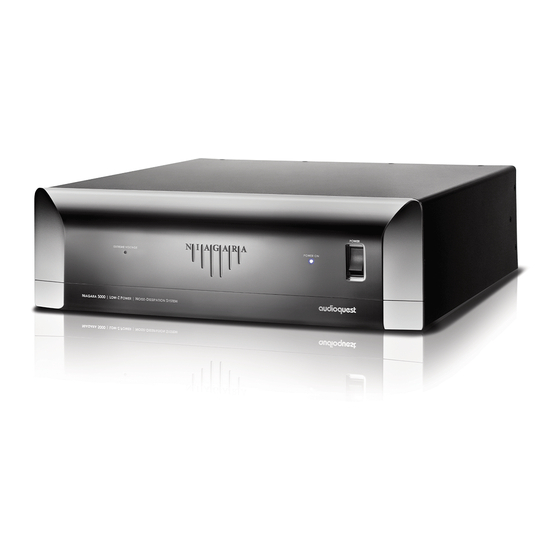AudioQuest NIAGARA 5000UK Manuel du propriétaire - Page 14
Parcourez en ligne ou téléchargez le pdf Manuel du propriétaire pour {nom_de_la_catégorie} AudioQuest NIAGARA 5000UK. AudioQuest NIAGARA 5000UK 17 pages. Noise-dissipation system
Également pour AudioQuest NIAGARA 5000UK : Manuel de démarrage rapide (2 pages)

If the power amplifier(s) are plugged into the High-Current/Power Correction AC outlets, make certain that
the rear-panel Power Correction switch is in the "Engaged"/"1" position. Although it is possible for the Power
Correction Circuit to work properly while the switch is in the "Bypass" position (see "Power Correction Switch"),
you might find that the unit sounds substantially better in the "Engaged" position. If this is the case, it is possible
that the main or primary power amplifier(s) are not plugged into High-Current AC Bank 1, the power amplifier has
insufficient current draw to activate the circuit, or the circuit is mis-calibrated.
When the Power Correction switch is set to the "Engaged" position, the current sense circuit will be defeated. Yet,
even with the current sense circuit functioning properly, audiophiles may prefer the "Engaged" position, as it will
slightly decrease the impedance of the Transient Power Correction Circuit.
My Niagara 5000UK has no power amplifiers connected to it, but it sounds odd or
not quite as good as it once did.
The Transient Power Correction Circuit also affects the Level-X Ultra-Linear Noise-Dissipation Circuits. Make certain
that the rear-panel Power Correction switch is in the "Engaged"/"1" position.
A technician or electrician found that my Niagara 5000UK consumes over 8 amps
of current. Is it broken?
No, it's not broken, and it's not drawing 8+ amps in any conventional sense. The Niagara 5000UK's Transient
Power Correction Circuit creates a reactive current draw of as much as 9 to 10 amps RMS at idle, and, when
incorporated with power supplies such as those found in power amplifiers, the current readings decrease. This
is a vector load, which will vary with the connected equipment. When plugged into an AC service that has no
other electrical draw, it is typical to see a real-world RMS power draw well below 30 watts at idle. (For an in-depth
explanation of the circuit, see "Power Correction Switch. " )
My home or grounds were hit by lightning. The Niagara 5000UK seems to be
functioning properly. Should it be sent in for inspection or service?
If you see or smell smoke coming from the unit, it needs service. Otherwise, if it functions after such an event
(which is very likely), there is nothing that would be compromised or damaged. If it fails after such an event, it
will fail totally. However, it's unlikely that this would occur. The circuit is designed to easily handle any voltage
or current surge that could possibly make it past an electrical panel. The force required to damage the Niagara
5000UK via a power surge would melt the panel and burn the building (in which case, the Niagara 5000UK is the
least of your worries).
How do I clean the chassis and/or the electrical contacts?
The Niagara 5000UK's black-painted chassis and dark chrome front panel can be cleaned with AudioQuest
CleanScreen, automotive polishing creams, or a modest misting of household window cleaners. Please use soft
cotton or wool toweling to remove the liquid from the metal and painted surface. Whenever possible, use the
supplied polishing rag for the front panel, only using liquid cleaner when oil or grime is beyond the polishing
cloth's capacity to thoroughly clean. Never use alcohol or solvent-based cleaners. They can damage the surfaces,
paint, and silk-screening material.
The AC inlet, outlet posts, and grips are all generously plated with silver. There is no need to clean these if they
are not exposed to foreign substances such as grease and dirt. Silver oxide is a superior conductor to silver itself.
If cleaning is required, Isopropyl alcohol (preferably 99% purity) on a cotton swab is best for the inlet tabs. Some
manufacturers provide specialized cleaners for the AC output surfaces. Again, however, cleaning these surfaces
will most likely be unnecessary.
14
